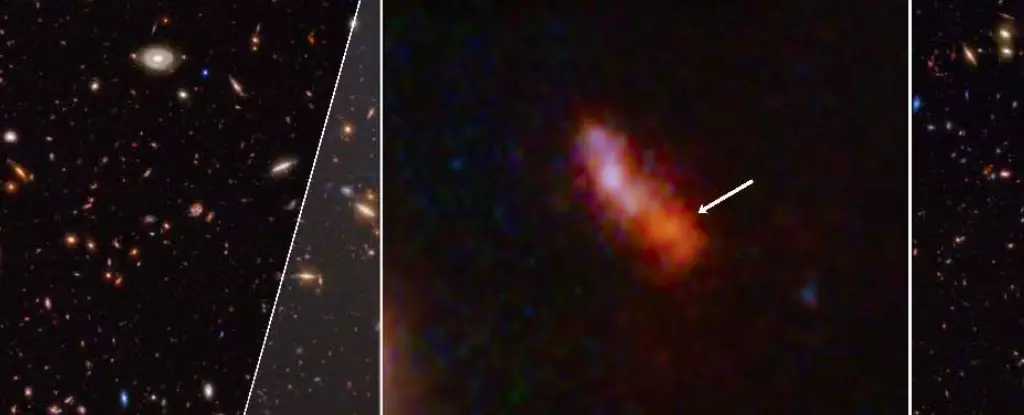The James Webb Space Telescope (JWST) is not just another impressive feat of engineering; it is rapidly transforming our comprehension of the cosmos and its early stages. With each observation, JWST pushes the boundaries of astronomical research further back in time, revealing bright galaxies from the universe’s infancy, mere hundreds of millions of years after the Big Bang. Recently, astronomers announced the detection of an extraordinary galaxy known as MoM-z14, which dates back to just 280 million years post-Big Bang, making it the most distant galaxy detected to date—an astonishing achievement that opens new avenues for exploration.
In contrast to its predecessors, the JWST boasts a more extensive mirror and enhanced infrared detection capabilities, allowing it to penetrate through the obscuring veil of the early universe more effectively than ever before. While Hubble’s near-infrared observations were limited by its 2.4-meter mirror, and the Spitzer Space Telescope was constrained by its 85 cm mirror, JWST leverages substantial advancements in technology and design. The ability to probe deeper into the cosmos has provided us with a wealth of information, challenging pre-existing assumptions about galaxy formation during the earliest epochs.
Unveiling Cosmic Miracles: The MoM-z14 Discovery
The official identification and validation of MoM-z14 is a remarkable feat achieved through the Mirage or Miracle survey specifically aimed at confirming high-redshift galaxies. This galaxy’s detection marks a significant departure from existing models predicting the existence of galaxies at such extreme redshifts. As highlighted by Rohan Naidu, the lead author of the pivotal paper detailing these findings, the JWST has unveiled a “stunning population of bright galaxies at surprisingly early epochs” of the universe, indicating that our previous understanding was constrained by technology rather than reality.
The implications of these findings are profound—MoM-z14, cataloged with a redshift of 14.4, expands our observational frontier, compelling astronomers to reassess how and when galaxies began to form and evolve. This discovery has triggered a cascade of questions, particularly concerning the role of early star formation and the factors that enabled such bright emissions to occur at a time when the universe was still in its formative years.
Deciphering the Chemical Composition of Early Galaxies
The JWST’s spectroscopic capabilities have facilitated a deeper understanding of the chemical makeup of the newly discovered MoM-z14 galaxy. The research reveals that the galaxy’s luminosity predominantly arises from its stars rather than an active galactic nucleus (AGN). This provides intriguing evidence for a population of supermassive stars that may not have been previously considered, validating theoretical predictions regarding early galaxy compositions.
The study of MoM-z14’s chemical composition has revealed an abundance pattern that closely aligns with ancient globular clusters within our Milky Way, suggesting that the processes of star formation and nucleosynthesis in its formation context mirror those ancient environments. This connection invites a breathtaking exploration of how galaxy evolution is intricately interwoven throughout cosmic time.
Transforming Galactic Archeology: New Relationships in Morphology and Chemistry
The research into MoM-z14 has also uncovered an exciting link between the galaxy’s morphology and its chemical characteristics. The authors note the distinction between two types of ancient galaxies: point sources and extended structures. This morphological variability appears to have profound implications for how we understand galactic evolution, particularly when we consider the composition differences and their potential impacts on star formation dynamics.
Emerging classifications, such as the notable increase in nitrogen emitters—including luminous objects like MoM-z14—further illuminate the complex relationships within early galaxy populations. The findings suggest the presence of systematic differences in chemical enrichment patterns between compact and extended galaxies, hinting at varied evolutionary pathways. Such insights could redefine our understanding of the pathways that galaxies take from their nascent stages to mature formations.
Looking Forward: The Future of Cosmic Exploration
As the astronomical community eagerly anticipates further data from the JWST and the forthcoming Roman Space Telescope, the potential to expand our understanding of the origins and evolution of the universe is exhilarating. With each unexpected discovery, astronomers are piecing together a cosmic puzzle that reveals a vibrant and dynamic landscape, filled with ancient galaxies and potential connections to our Milky Way’s history.
The JWST’s groundbreaking discoveries like MoM-z14 are just the beginning. They prompt not only admiration but also serious contemplation about the universe’s earliest epochs, illuminating pathways for future research that can redefine our celestial narratives. As we stand on the precipice of a new era in cosmic exploration, the universe’s mysteries seem less daunting and more like an exciting expanse waiting to be uncovered.

